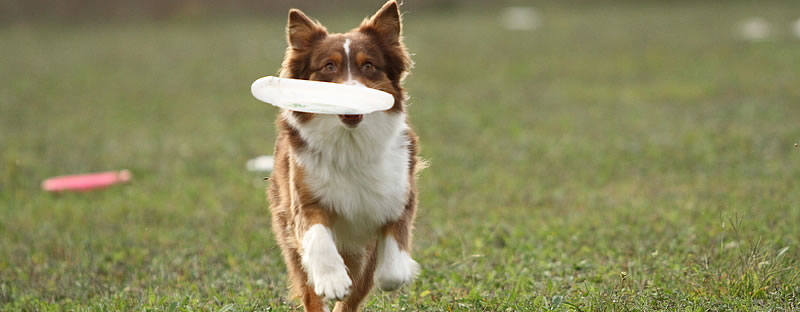
Improving Your Disc Dog’s Retrieve Speed in Toss and Fetch
I have been asked on more than one occasion,”How do I get a faster Retrieve from my dog in toss and fetch?”
It’s a simple answer: give your dog a reason to haul butt back to you. This simple fact often escapes handlers because we all get caught up in the game of toss and fetch – the time, the distance, and the single disc – and we go out and practice, practice, practice the game by the rules.
This is classic cart before the horse thinking and flies in the face of any kind of athletic training one can think of.
Imagine a football team that practiced only by scrimmaging (live game simulation). No walk throughs of plays, no running tires, no tackling drills, no catching drills, no practicing kickoffs and kickoff returns. This team would not be very good because they would lack many of the basic foundational skills that are required to play well and win games.
A quality football practice violates the rules of the game of football all the time. A great practice creates many situations that are not even remotely possible in a live game situation. These violations do not ruin the players. They do not make it more difficult to compete. These violations of the rules of football isolate and develop the skills necessary to be successful at the game of football. Rule violations create better and more competent players.
Why is it then that disc dog handlers when playing toss and fetch refuse to alter the rules of the game to teach the skills necessary for great toss and fetch performance?
Simply practicing Toss and Fetch by the rules and on the clock is not likely to lead to a faster retrieve or better Drop or Give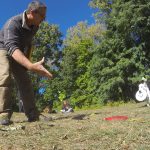 The Give is a retrieve to the hand. A cued Give is a foundational skill that is not super useful in the actual performance of disc dog freestyle, and has huge applications for... More performance.
The Give is a retrieve to the hand. A cued Give is a foundational skill that is not super useful in the actual performance of disc dog freestyle, and has huge applications for... More performance.
Pressure
A disc dog is sent around and then runs freely after a target that she truly desires. A wide open field is in front of her. The thrill of the catch consumes her. As soon as she makes the catch, she turns around and is greeted by what?
More often than not, she’s greeted by a handler screaming and yelling so she approaches cautiously. Why wouldn’t they?
A dog does not vigorously approach a handler that is facing them without having been taught to do so. This happens naturally for some teams, because when the dog arrives the next disc is thrown. This is sufficient reinforcement for some dogs, but it is not enough reinforcement for all dogs.
A simple recommendation for increasing the retrieve speed of a dog is to follow the throw – jog out 15-20 yards as the dog is chasing the disc – and as soon as she makes the turn back towards you after the catch, turn and run back to the line as fast as you can. Call her name as well to get her attention and to trigger the understanding and desire you have cultivated through good recall (come when called) work.
There really is no excuse for not doing this on every throw except for being lazy and stubborn. It works extremely well, providing an immediate and noticeable increase in speed while building strong teamwork in the game of toss and fetch.
There Is No Time in Dog Training
When a dog arrives at the handler she is rewarded with having her disc taken away. If there is any problem with the transfer of the disc from dog to handler, which there often is because the clock is ticking and every second counts, the dog is further rewarded with anxiety, chaos, confusion, frustration and stress. “I have no idea why she doesn’t want to get back quicker.”
Turn off the timer during practice. If time and performance are very important to you, add the timer back into the game a few weeks before the contest, after the team has an awesome mouth to hand transfer or clean drop at the feet on the playing field.
Freeshaping the drop is a great tool for obtaining a great drop at the handler. It takes the pressure off the Give and allows the dog, and the dog’s behavior to be in control over reinforcement and the pace of the game.
Add Another Disc
Some people consider this sacrilege or blasphemy in Toss and Fetch. I mean, it violates everything that the game is about.
There are several legitimate reasons to be wary of adding another disc, but they wither upon further inspection. Let’s look at one of them in particular, it’s by far the most frequent reason for not practicing toss and fetch with multiple discs:
“If I use two discs the dog will never play with just 1.” This fallacy is shattered when thinking of getting rid of cookies in dog training – do you have to have a cookie to get your dog to sit? How about using a partner to teach a dog to vault?
I think the main reason that people make this excuse for not using two discs is that they believe Toss and Fetch is easy and should be an expected skill and that using another disc would be cheating. How’s that working out for ya?
Adding another disc gives the handler more control over reinforcing the dog. In the case of freeshaping a drop, it allows the handler to immediately reinforce the dog for a solid drop – no more fighting over the disc on the ground and instant reinforcement with a throw.
It also allows the handler to perform two key skills that will develop a faster retrieve.
We’ll talk about those in the next installment.
As always, please share your thoughts, comments and questions in the comment section below.
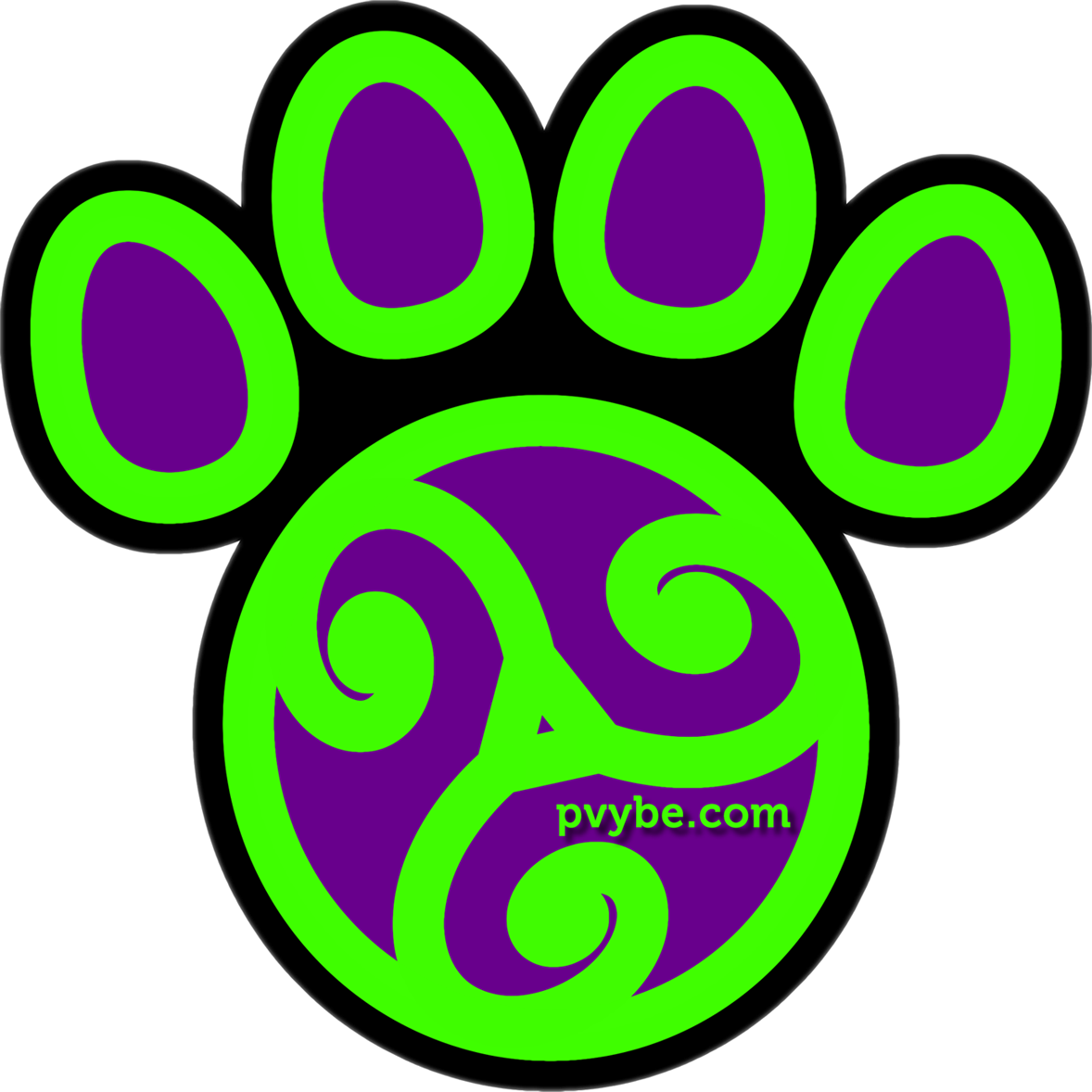


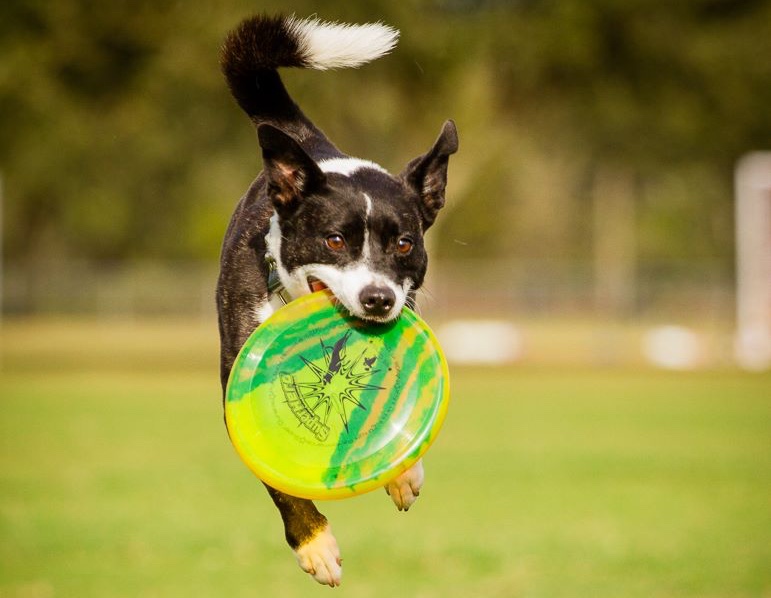
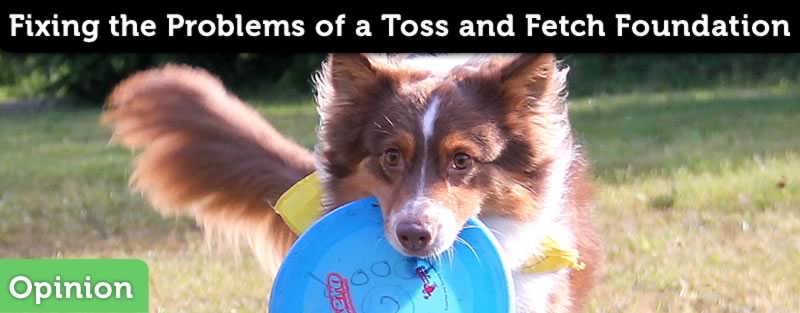
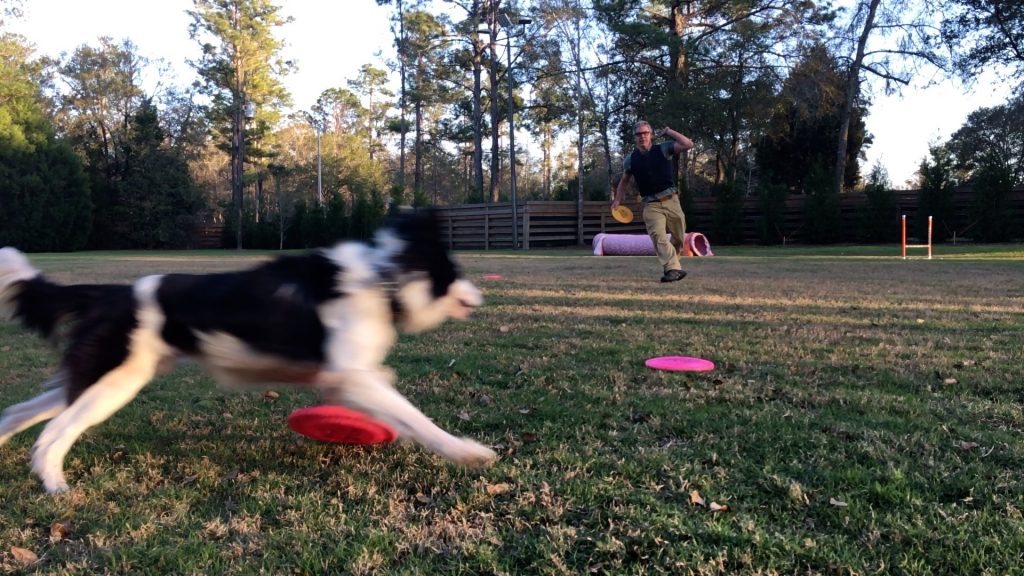

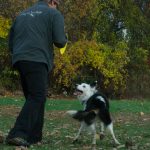
Thanks Ron!!! Great article and advice! I am going to do exactly that the next time I go out to play (today I hope since it’s so nice out here)
I had a problem with Rayne bring the disc back to me so I started rewarding with tug play everytime she would bring it back. I created another issue doing this though :(. She runs back faster then she runs for the disc which is awesome BUT she comes barreling at me growling and wanting to play tug *laugh*.. but not funny when I need that drop “NOW” ! So now I am trying to get a drop and keep her excited and not lose that barreling speed on her come back..
After attending the Skyhoundz Worlds and seeing how everyone plays T/F and getting those 25 pointer rounds I am becoming obbsessed at wanting that as well!! I do need a 40 yard throw though *laugh* which I will make myself do by next year!!
Thanks for all your articles they help so many of us become better disc doggers and better team mates for or dogs!
So when and where is the next Camp in our area for 2012 we Albertains can get to????
Marion Paulson
Calgary Alberta
Hey Marion,
You might want to try working on a drop in a different situation. You can use 2 disc bitework to get the behavior working, and then start to proof it with a single disc.
And also keep in mind that a Drop is different than Give. They should have different cues and should not be conflated or settled for by a handler that is on the clock.
That conflation and confusion surrounding Drop and Give is a big problem with many teams, add in a ticking clock and it becomes a serious problem.
Peace~
Awesome thanks Ron..We have a disc project to work on now *S*
Did you see the next installment, Marion?
http://pvybe.com/latest/a-faster-toss-and-fetch-retrieve-with-2-discs-and-bitework/
I got one more in this series. It will be right up your alley. Stay tuned….
LOL Lazy and stubborn. Oh boy I just looked in the mirror for that one. I’ll be adding the run out and turn to every throw now. Thanks for the nudge. 😉
I was totally thinking of myself when I wrote it too. I’ll catch myself all the time standing there watching my dogs run back in.
Hey Marion-
Had the same issue with my young dog Huck – did such a great job building the bite and drive back I lost the single disc drop and got a thrashing tug. So now we never tug the disc – I use verbal praise and reinforcement and at the end of the round I smack him around playfully and let him jump up in my arms since that’s his favorite so he still gets reward.
Find another way to reinforce him in T&F other than the tug and you’ll get to keep the nice bite and fast return, without the tugging on the disc. The tug, drop is a separate training session now – and never with a disc anymore. We do bite drop with the disc.
Great reminder Ron about give and drop – and as always a great article!
Stop spying on my T/F practices! 😉
Spot on Ron and added a bit for me to think about. One thing we add as well are flyball type restraint recalls. Watch a good flyball dog play disc and you will understand why.
Marion. Keep doing what you are doing but add one thing. Ask for the out or Give first, THEN tug like crazy every time. Then you vary it up and do it every other time after you have gotten that crazy drive.
@Rick – Restrained recall is a solid tool. I didn’t mention it because not many people want to do “dog training” work for Frisbee. 😉
Another great point about the Drop or Give then the tug. That way nothing exciting happens until the desired behavior happens and the Drop or Give becomes a secondary reinforcer. I would add to it more focus on bite and drop and less on the tug.
@Dre – Wish I would have been around while you were grooming Huck, I might have saved you a couple of fingernails. 🙂 There is no real need for Bitework after your dog is killing targets as they are presented, Drops and Gives (while high on drive) on cue and has a strong sense of value around the handler. If I had to guess you went overboard on the Tugging for drive building and didn’t do enough Bitework for Behavior. It’s easy to do especially if you have not experienced it before.
Peace~
Yep. Some lessons really hit home the first time. 🙂 Think I’ve got enough drive and bite now…
Great post and comments. The tug worked miracles for Ares’ hand off. After trying for years to get Ares to stop his “fly by’s” on his return and to come directly to me, I finally got it. It took tugging with him at every return, especially at events, knowing that we were sacrificing time by tugging, but that there was an end to the means and it was better than sacrificing time by chasing him around behind the line with no chance for improving it. FINALLY, we reached a point, a few years ago, where I did not even have to think about Ares running past me in T&F. I was still overjoyed every time he ran directly to me because it became the focus of our game for so long. The catch was a given, the return was as fast as he could run, but giving me the disc was the hard part. It was such a focus that I was more excited by a round of T&F that resulted in 4-5 direct returns than any score I got. I got 2 full seasons of not worrying at all about that return, until last year. He started running past me again. Grrrr. Thing is, at this point, because he’s 9 now, I’m not sure if he’s doing it to catch his breath and take a short time out before I ask him to haul ass down the field again in the hot sun, or if he’s just reverting to his old ways. Near the end of this season, I started back with tugging on the return during competitions and at home to try to get that awesome hand off back again. What I have noticed at home and at the park is that when the temperatures are cool and he’s fresh, he’s handing it off PERFECTLY. But, if he is hot or if he starts to get a little tired, he does the fly by. Now that it’s cooler, he’s playing longer with direct returns. It’s because of that, that I question his motives on the disc dog field. I struggle with trying to understand the motive. If it’s because he’s 9 and hot and tired and maybe even sore or tight, fine, take all the time you need. But, if it’s because he’s controlling the game for other reasons, knock it off!!! LOL By going back to the tug and making that exchange FUN again, I’m hoping to get back to where we were. But, because he has completely blown off a final throw in T&F or extreme distance a few times now, at the end of a long, hot day, watching the disc fly down the field as he stands there next to me, maybe sauntering towards it, I suspect that he now has limits that he didn’t used to have. I am happy to know that he has the sense to take care of himself, unlike many of the working dogs. He’s still in amazing shape and still has crazy energy, so I hope we can get back our T&F game for next season.
Right on, Deneane!
We’ve been talking about that slight fatigue making problem behaviors crop up in Disc Dog Foundation class over the last couple weeks. It’s pretty common, actually. Good job going back to basics – that’s what they’re for.
I can’t believe that he’s 9! lol
Peace~
Meant to check the box for email notification on follow-up comments, so I’m writing this reply to do that. 🙂